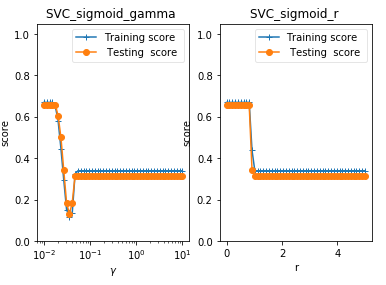吴裕雄 python 机器学习——支持向量机SVM非线性分类SVC模型
import numpy as np
import matplotlib.pyplot as plt from sklearn import datasets, linear_model,svm
from sklearn.model_selection import train_test_split def load_data_classfication():
'''
加载用于分类问题的数据集
'''
# 使用 scikit-learn 自带的 iris 数据集
iris=datasets.load_iris()
X_train=iris.data
y_train=iris.target
# 分层采样拆分成训练集和测试集,测试集大小为原始数据集大小的 1/4
return train_test_split(X_train, y_train,test_size=0.25,random_state=0,stratify=y_train) #支持向量机SVM非线性分类SVC模型
def test_SVC_linear(*data):
X_train,X_test,y_train,y_test=data
cls=svm.SVC(kernel='linear')
cls.fit(X_train,y_train)
print('Coefficients:%s, intercept %s'%(cls.coef_,cls.intercept_))
print('Score: %.2f' % cls.score(X_test, y_test)) # 生成用于分类的数据集
X_train,X_test,y_train,y_test=load_data_classfication()
# 调用 test_SVC_linear
test_SVC_linear(X_train,X_test,y_train,y_test)

def test_SVC_poly(*data):
'''
测试多项式核的 SVC 的预测性能随 degree、gamma、coef0 的影响.
'''
X_train,X_test,y_train,y_test=data
fig=plt.figure()
### 测试 degree ####
degrees=range(1,20)
train_scores=[]
test_scores=[]
for degree in degrees:
cls=svm.SVC(kernel='poly',degree=degree)
cls.fit(X_train,y_train)
train_scores.append(cls.score(X_train,y_train))
test_scores.append(cls.score(X_test, y_test))
ax=fig.add_subplot(1,3,1) # 一行三列
ax.plot(degrees,train_scores,label="Training score ",marker='+' )
ax.plot(degrees,test_scores,label= " Testing score ",marker='o' )
ax.set_title( "SVC_poly_degree ")
ax.set_xlabel("p")
ax.set_ylabel("score")
ax.set_ylim(0,1.05)
ax.legend(loc="best",framealpha=0.5) ### 测试 gamma ,此时 degree 固定为 3####
gammas=range(1,20)
train_scores=[]
test_scores=[]
for gamma in gammas:
cls=svm.SVC(kernel='poly',gamma=gamma,degree=3)
cls.fit(X_train,y_train)
train_scores.append(cls.score(X_train,y_train))
test_scores.append(cls.score(X_test, y_test))
ax=fig.add_subplot(1,3,2)
ax.plot(gammas,train_scores,label="Training score ",marker='+' )
ax.plot(gammas,test_scores,label= " Testing score ",marker='o' )
ax.set_title( "SVC_poly_gamma ")
ax.set_xlabel(r"$\gamma$")
ax.set_ylabel("score")
ax.set_ylim(0,1.05)
ax.legend(loc="best",framealpha=0.5)
### 测试 r ,此时 gamma固定为10 , degree 固定为 3######
rs=range(0,20)
train_scores=[]
test_scores=[]
for r in rs:
cls=svm.SVC(kernel='poly',gamma=10,degree=3,coef0=r)
cls.fit(X_train,y_train)
train_scores.append(cls.score(X_train,y_train))
test_scores.append(cls.score(X_test, y_test))
ax=fig.add_subplot(1,3,3)
ax.plot(rs,train_scores,label="Training score ",marker='+' )
ax.plot(rs,test_scores,label= " Testing score ",marker='o' )
ax.set_title( "SVC_poly_r ")
ax.set_xlabel(r"r")
ax.set_ylabel("score")
ax.set_ylim(0,1.05)
ax.legend(loc="best",framealpha=0.5)
plt.show() # 调用 test_SVC_poly
test_SVC_poly(X_train,X_test,y_train,y_test)

def test_SVC_rbf(*data):
'''
测试 高斯核的 SVC 的预测性能随 gamma 参数的影响
'''
X_train,X_test,y_train,y_test=data
gammas=range(1,20)
train_scores=[]
test_scores=[]
for gamma in gammas:
cls=svm.SVC(kernel='rbf',gamma=gamma)
cls.fit(X_train,y_train)
train_scores.append(cls.score(X_train,y_train))
test_scores.append(cls.score(X_test, y_test))
fig=plt.figure()
ax=fig.add_subplot(1,1,1)
ax.plot(gammas,train_scores,label="Training score ",marker='+' )
ax.plot(gammas,test_scores,label= " Testing score ",marker='o' )
ax.set_title( "SVC_rbf")
ax.set_xlabel(r"$\gamma$")
ax.set_ylabel("score")
ax.set_ylim(0,1.05)
ax.legend(loc="best",framealpha=0.5)
plt.show() # 调用 test_SVC_rbf
test_SVC_rbf(X_train,X_test,y_train,y_test)

def test_SVC_sigmoid(*data):
'''
测试 sigmoid 核的 SVC 的预测性能随 gamma、coef0 的影响.
'''
X_train,X_test,y_train,y_test=data
fig=plt.figure() ### 测试 gamma ,固定 coef0 为 0 ####
gammas=np.logspace(-2,1)
train_scores=[]
test_scores=[] for gamma in gammas:
cls=svm.SVC(kernel='sigmoid',gamma=gamma,coef0=0)
cls.fit(X_train,y_train)
train_scores.append(cls.score(X_train,y_train))
test_scores.append(cls.score(X_test, y_test))
ax=fig.add_subplot(1,2,1)
ax.plot(gammas,train_scores,label="Training score ",marker='+' )
ax.plot(gammas,test_scores,label= " Testing score ",marker='o' )
ax.set_title( "SVC_sigmoid_gamma ")
ax.set_xscale("log")
ax.set_xlabel(r"$\gamma$")
ax.set_ylabel("score")
ax.set_ylim(0,1.05)
ax.legend(loc="best",framealpha=0.5)
### 测试 r,固定 gamma 为 0.01 ######
rs=np.linspace(0,5)
train_scores=[]
test_scores=[] for r in rs:
cls=svm.SVC(kernel='sigmoid',coef0=r,gamma=0.01)
cls.fit(X_train,y_train)
train_scores.append(cls.score(X_train,y_train))
test_scores.append(cls.score(X_test, y_test))
ax=fig.add_subplot(1,2,2)
ax.plot(rs,train_scores,label="Training score ",marker='+' )
ax.plot(rs,test_scores,label= " Testing score ",marker='o' )
ax.set_title( "SVC_sigmoid_r ")
ax.set_xlabel(r"r")
ax.set_ylabel("score")
ax.set_ylim(0,1.05)
ax.legend(loc="best",framealpha=0.5)
plt.show() # 调用 test_SVC_sigmoid
test_SVC_sigmoid(X_train,X_test,y_train,y_test)

吴裕雄 python 机器学习——支持向量机SVM非线性分类SVC模型的更多相关文章
- 吴裕雄 python 机器学习——支持向量机线性分类LinearSVC模型
import numpy as np import matplotlib.pyplot as plt from sklearn import datasets, linear_model,svm fr ...
- 吴裕雄 python 机器学习——支持向量机非线性回归SVR模型
import numpy as np import matplotlib.pyplot as plt from sklearn import datasets, linear_model,svm fr ...
- 吴裕雄 python 机器学习——支持向量机线性回归SVR模型
import numpy as np import matplotlib.pyplot as plt from sklearn import datasets, linear_model,svm fr ...
- 吴裕雄 python 机器学习——集成学习AdaBoost算法回归模型
import numpy as np import matplotlib.pyplot as plt from sklearn import datasets,ensemble from sklear ...
- 吴裕雄 python 机器学习——多项式贝叶斯分类器MultinomialNB模型
import numpy as np import matplotlib.pyplot as plt from sklearn import datasets,naive_bayes from skl ...
- 吴裕雄 python 机器学习——人工神经网络与原始感知机模型
import numpy as np from matplotlib import pyplot as plt from mpl_toolkits.mplot3d import Axes3D from ...
- 吴裕雄 python 机器学习——数据预处理包裹式特征选取模型
from sklearn.svm import LinearSVC from sklearn.datasets import load_iris from sklearn.feature_select ...
- 吴裕雄 python 机器学习——等度量映射Isomap降维模型
# -*- coding: utf-8 -*- import numpy as np import matplotlib.pyplot as plt from sklearn import datas ...
- 吴裕雄 python 机器学习——多维缩放降维MDS模型
# -*- coding: utf-8 -*- import numpy as np import matplotlib.pyplot as plt from sklearn import datas ...
随机推荐
- vue加载单文件使用vue-loader报错
报错信息如下:ERROR in ./src/login.vue Module Error (from ./node_modules/vue-loader/lib/index.js): vue-load ...
- Android_侧滑菜单的实现
1.创建侧滑菜单Fragment package com.example.didida_corder; import android.os.Bundle; import android.view.La ...
- mybatis-plus热部署mapper.xml插件JRebel MybatisPlus extension,报错:java.lang.NullPointerException
事件 mybatis转mybatis-plus,结果原来的Jrebel for intrllij 不能热部署mapper.xml文件,百度得知得添加新的插件 JRebel MybatisPlus ex ...
- #助力CSP2019# OI中容易出现的**错误汇总
多测不清空,爆0两行泪 3年OI一场空,不开long long见祖宗 线段树空间需要开4倍 读入有负数的时候,如果要写快读,要识别负号 持续更新
- ansible笔记(14):循环(一)
在使用ansible的过程中,我们经常需要处理一些返回信息,而这些返回信息中,通常可能不是单独的一条返回信息,而是一个信息列表,如果我们想要循环的处理信息列表中的每一条信息,我们该怎么办呢?这样空口白 ...
- Selenium3+python自动化013-操作浏览器的Cookie
为什么要用Cookie?在测试多个页面时候可绕过验证码输入,直接添加cookie,也可以在添加唯一标识时候使用. 一.操作浏览器的Cookie 1.1.验证码的处理方式 说明:WebDriver类库中 ...
- springboot整合websocket实现客户端与服务端通信
定义 WebSocket是通过单个TCP连接提供全双工(双向通信)通信信道的计算机通信协议.此WebSocket API可在用户的浏览器和服务器之间进行双向通信.用户可以向服务器发送消息并接收事件驱 ...
- HTML表单处理
一.表单简介 表单的处理是一个多进程.首先创建一张表单,以供用固话输入详细的请求信息.接着,输入的数据被发送到服务器,在服务器里这些数据得到编译和错误检测.如果PHP代码识别出一个或多个需要重新输入的 ...
- 棋盘划分问题中4的k次方减一是三的倍数
1.数学归纳法(万物皆可数学归纳) ①当n=1时:4-1=3(是三的倍数) ②假设n-1成立证明n成立:4n-1=4n-1*(4-1)+4n-1-1 =3*4n-1+(4n-1-1) 所以4n-1%3 ...
- 【音乐欣赏】《Heart Made of Stone》 - The Tech Thieves
曲名:Heart Made of Stone 作者:The Tech Thieves Yeah It's been years now and I wonder Is it over? Do you ...
